
A few weeks ago, I was contacted by a real enthusiast of quince. As he announces on his website – his dream is to popularise this wonderful plant so that it is as popular and recognised in 20 years’ time as currant, gooseberry, chokeberry, or huckleberry. He caught my interested with his passion and I need to admit that we found a common ground right away. I admire people who are involved in agriculture on a daily basis. I think that such work requires a lot of experience, patience, and humbleness. In times, when the quick effect and benefits are desires such attitude is even more difficult to maintain. I already mentioned quince on the blog (here). Back then, I was beginning to familiarise myself with its health properties. Owing to the fact that it doesn’t require any crop spraying or chemical protection (e. g. fertilising, watering, and special treatments), it’s rich in vitamins. Apart from the sevenfold higher level of vitamin C than lemon, it also contains potassium, iron, phosphorus, magnesium, molybdenum, zinc, and calcium. Quince works wonders against viruses as it increases the production of interferon. It has antiatherosclerotic properties (it decreases the level of bad cholesterol in blood) and anti-cancer properties (it destroys free radicals – high vitamin C content and polypnehols). Apart from that, it regenerates liver, and, owing to the presence of potassium, it regulates blood pressure. The syrup and other preserves made of quince fruit combat diabetes as they have hypoglycemic properties.
* * *
Kilka tygodniu temu skontaktował się ze mną prawdziwy pasjonata pigwowca. Jak sam na swojej stronie oznajmia – jego marzeniem jest spopularyzowanie tej wspaniałej rośliny, żeby za 20 lat była tak popularna i rozpoznawalna jak porzeczka, agrest, aronia czy borówka amerykańska. Zaciekawił mnie swoją pasją i przyznam Wam, że od razu odnaleźliśmy wspólny język. Podziwiam ludzi którzy na co dzień zajmują się uprawą rolną. Myślę sobie, że praca wymaga ogromnego doświadczenia, cierpliwości i pokory. W czasach, kiedy szybki efekt i korzyści są pożądane taka postawa jest jeszcze trudniejsza. O pigwowcu już raz wspominałam na blogu (tutaj). Wówczas dopiero poznawałam jego właściwości prozdrowotne. Z uwagi na to, iż nie wymaga on żadnych oprysków ani ochrony chemicznej (np. nawożenia, podlewania i szczególnych zabiegów pielęgnacyjnych) jest tak bogaty w witaminy. Oprócz siedmiokrotnie większej porcji witaminy C niż cytryna, zawiera również potas, żelazo, fosfor, magnez, molibden, cynk, wapń. Pigwowiec posiada właściwości antywirusowe, gdyż wzmaga produkcję interferonu. Stwierdzono działanie przeciwmiażdżycowe (obniża poziom złego cholesterolu we krwi ) i antynowotworowe (niszczy wolne rodniki – wysoka zawartość witaminy C oraz polifenoli). Poza tym ma właściwości regenerujące wątrobę, a dzięki zawartości potasu reguluje ciśnienie krwi. Syrop i inne przetwory z owoców pigwowca przeciwdziałają cukrzycy, gdyż stwierdzono działanie hipoglikemiczne.
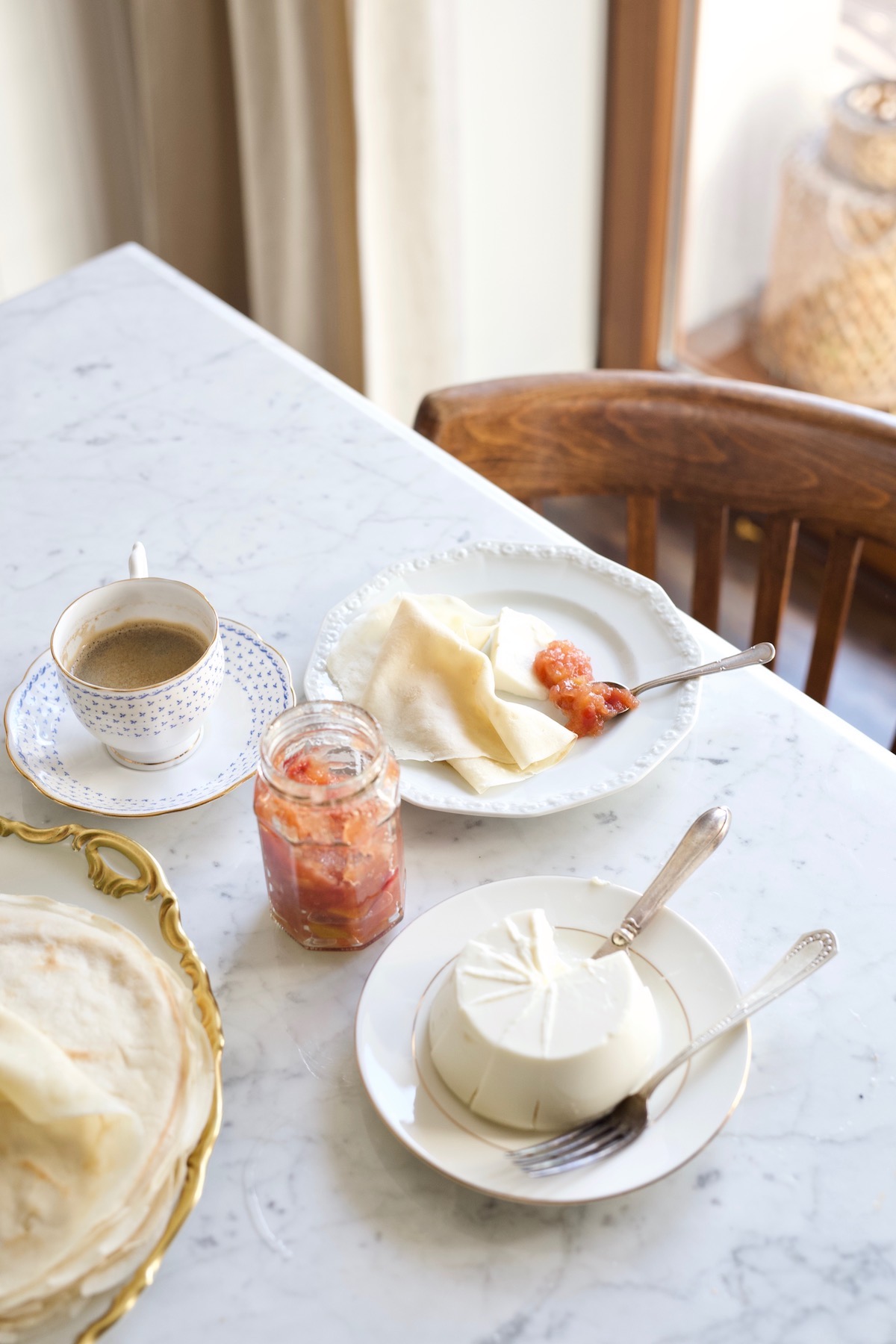 Ingredients:
Ingredients:
(recipe for approx. 8-10 pieces)
pancake dough:
1 glass of milk (3.2% butterfat)
1 glass of wheat floura pinch of cinnamon + 1 teaspoon of vanilla sugar
2 eggs
3/4 of a glass of sparkling water
clarified butter / rapeseed oil/ coconut oil for frying
quince fruit and apple preserve
1 kg of quince fruit
4-5 apples (e. g. russet apple)
400 g of sugarcinnamon + cloves
* * *
Skład:
(przepis na ok. 8-10 sztuk)
ciasto na naleśniki:
1 szklanka mleka 3,2 %
1 szklanka mąki pszennej
szczypta cynamonu + 1 łyżeczka cukru waniliowego
2 jajka
3/4 szklanki wody gazowanej
do smażenia: masło sklarowane / olej rzepakowy / olej kokosowy
konfitura z owoców pigwowca i jabłek
1 kg pigwowca
4-5 jabłek (np. zara reneta)
400 g cukru
cynamon / goździki
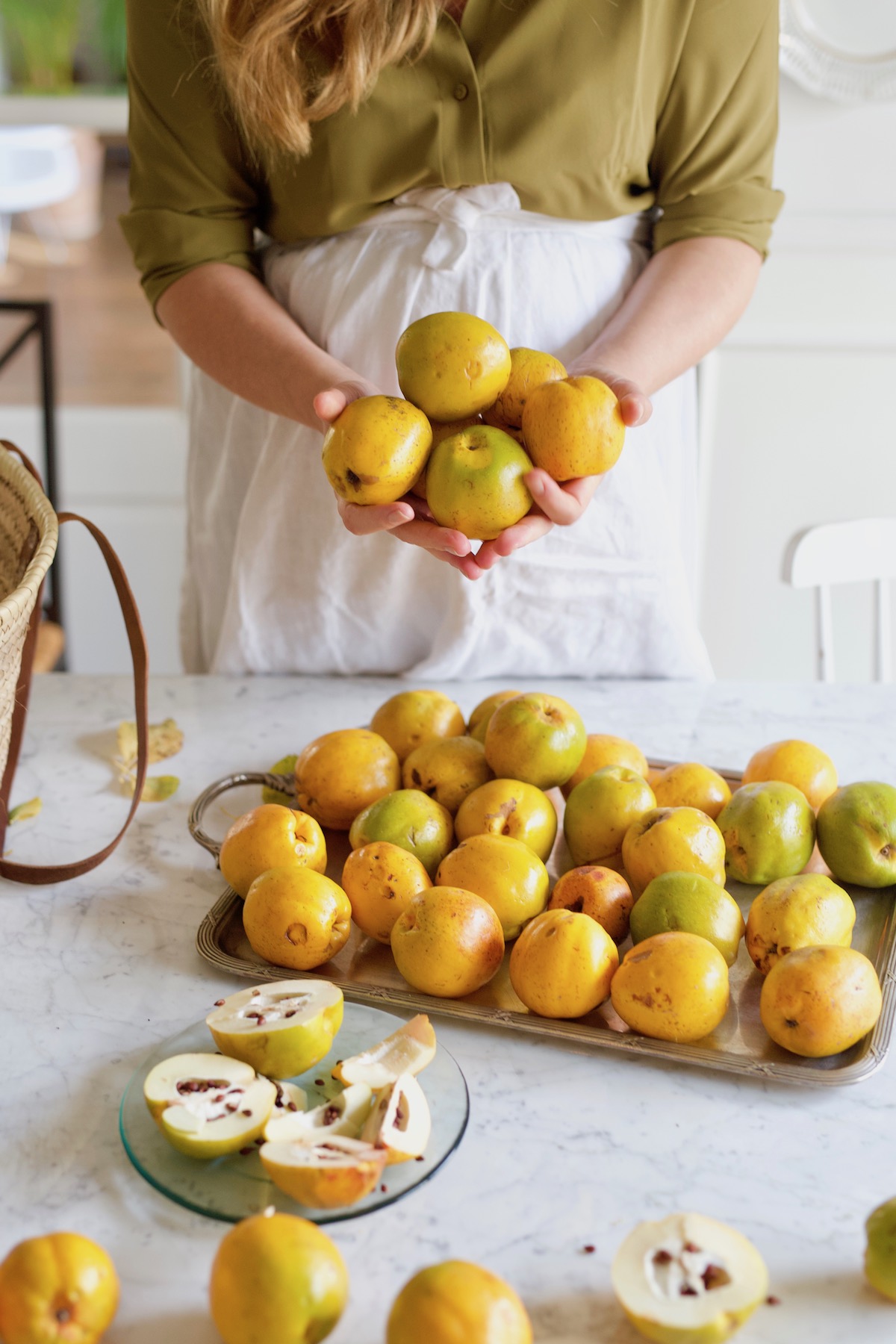
Directions:
1. To do the pancakes: mix all the dough ingredients (I use a blender) until smooth. Cool the dough in the fridge for at least 30 minutes. Fry the pancakes in a hot pan with some oil.
2. To prepare quince preserve: cut the washed quince fruit into quarters and get rid of the hard membranes and stones. Do the same with the apples. Combine the fruit in a large pot and cover them with sugar. Leave the pot in a cool place for 2 days and wait until they release juices.
3. After two days, pour the syrup into a pot and pasteurize it (the syrup is extremely rich in vitamin C that’s why we add it to tea in the winter season). Take the remaining fruit (the so-called expellers) and squeeze them as they are still hard and start frying them on low heat, adding cinnamon and cloves (according to your own taste). During braising, it’s worth adding some boiling water as quince fruit contain a lot of pectins and they become thick quickly. The ready preserve can be served with pancakes, ricotta, and thick Greek yoghurt. Important: to fry the pancakes, I use butter, rapeseed or coconut oil. It’s important to have an appropriately hot pan with non-stick layer. I use a cast-iron one.
* * *
A oto jak to zrobić:
1. Aby zrobić naleśniki: wszystkie składniki na ciasto miksujemy (korzystam z kielichowego blendera) na gładką konsystencję. Ciasto schładzamy w lodówce min. 30 minut. Na rozgrzanej patelni z tłuszczem smażymy naleśniki.
2. Aby zrobić konfiturę z pigwowca: umyte owoce pigwowca kroimy na ćwiartki i usuwamy środek (twarde błonki) oraz pestki. Z jabłkami czynimy to samo. Owoce łączymy w dużym garnku i zasypujemy cukrem. Odstawiamy w chłodne miejsce na 2 dni i czekamy, aż puszczą sok.
3. Po dwóch dniach powstały syrop zlewamy i pasteryzujemy (syrop ma wyjątkowo wysoką zawartością witaminy C dlatego w sezonie jesienn0 – zimowym pijemy z herbatą) a pozostałe owoce (tzw. wytłoki) ugniatamy, bo są nadal twarde i zaczynamy przesmażać na małym ogniu, dodając cynamon i goździki (wg własnego smaku). W trakcie duszenia warto dodać trochę wrzątku, gdyż owoce pigwowca zawierają bardzo dużo pektyn i dość szybko gęstnieją. Tak powstałą konfiturę podaję z naleśnikami, ricottą i gęstym jogurtem greckim.Ważne: Do smażenia naleśników używam masła oleju rzepakowego lub kokosowego, ważne, żeby zachować odpowiednio nagrzaną patelnię z nieprzywierającą powłoką. Ja używam żeliwnej.
 To prepare quince preserve: cut the washed quince fruit into quarters and get rid of the hard membranes and stones. Do the same with the apples.
To prepare quince preserve: cut the washed quince fruit into quarters and get rid of the hard membranes and stones. Do the same with the apples.
Aby zrobić konfiturę z pigwowca: umyte owoce pigwowca kroimy na ćwiartki i usuwamy środek (twarde błonki) oraz pestki. Z jabłkami czynimy to samo.
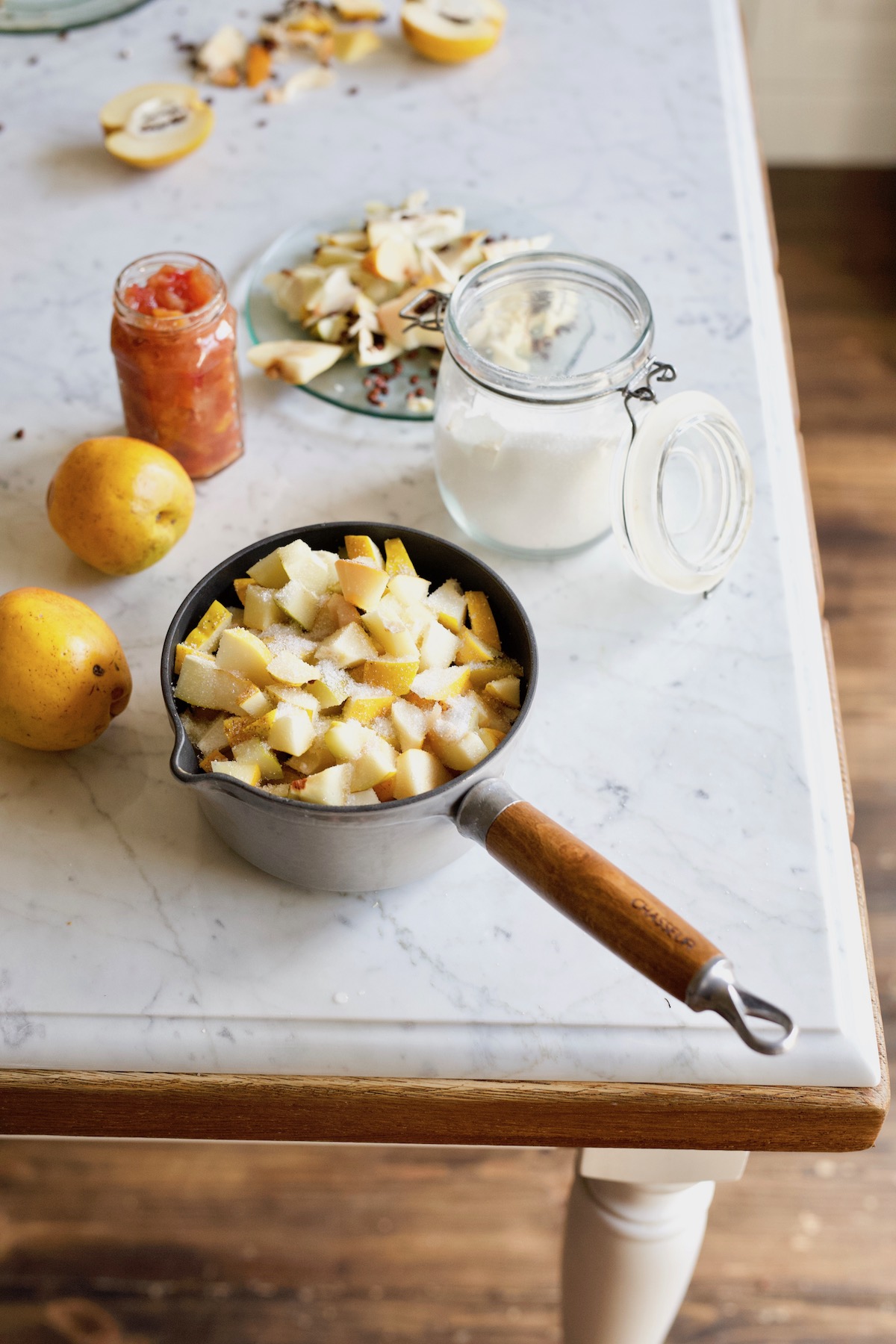 Combine the fruit in a large pot and cover them with sugar. Leave the pot in a cool place for 2 days and wait until they release juices.
Combine the fruit in a large pot and cover them with sugar. Leave the pot in a cool place for 2 days and wait until they release juices.
Owoce łączymy w dużym garnku i zasypujemy cukrem. Odstawiamy w chłodne miejsce na 2 dni i czekamy, aż puszczą sok.
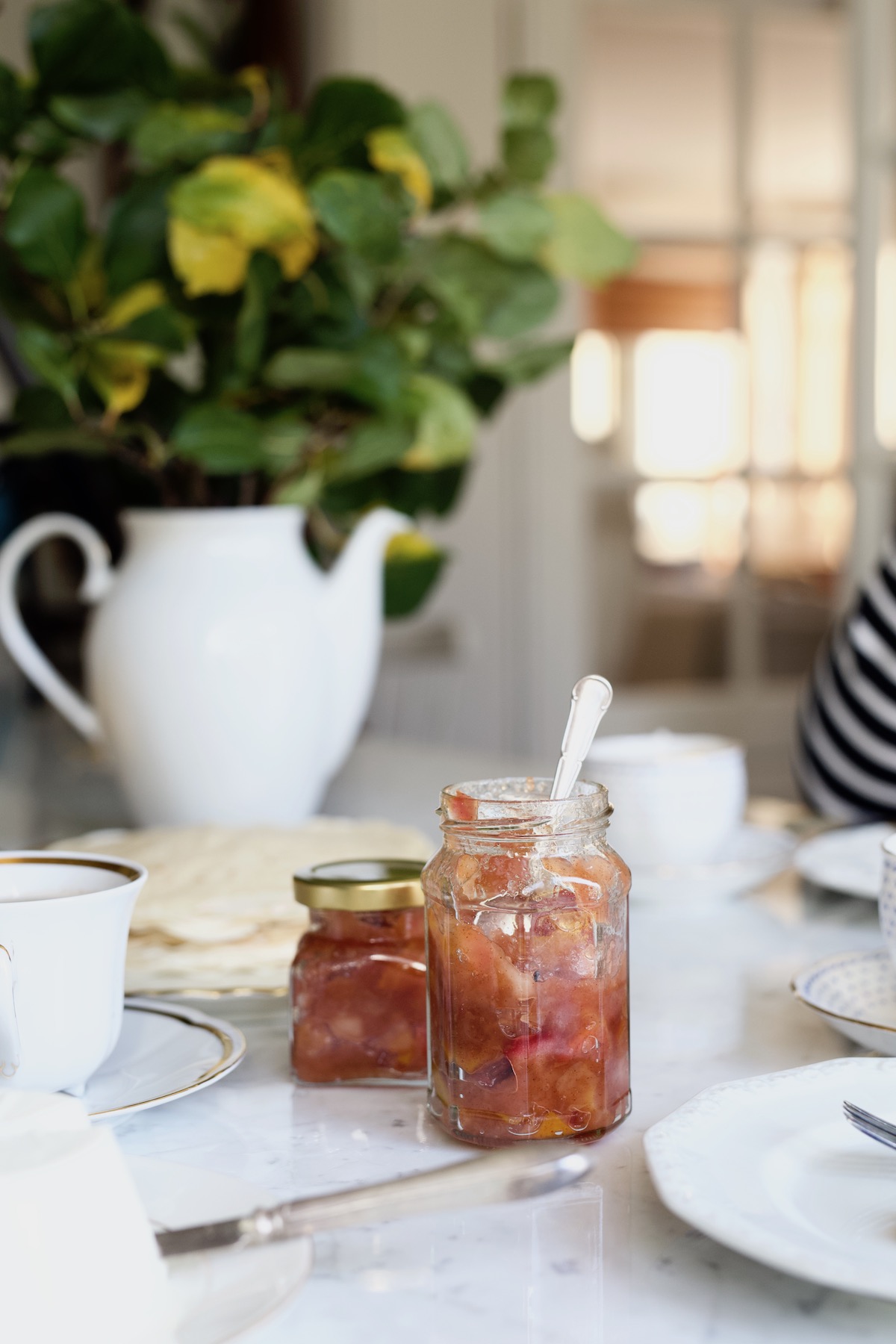 After two days, pour the syrup into a pot and pasteurize it (the syrup is extremely rich in vitamin C that’s why we add it to tea in the winter season). Take the remaining fruit (the so-called expellers) and squeeze them as they are still hard and start frying them on low heat, adding cinnamon and cloves (according to your own taste). During braising, it’s worth adding some boiling water as quince fruit contain a lot of pectins and they become thick quickly.
After two days, pour the syrup into a pot and pasteurize it (the syrup is extremely rich in vitamin C that’s why we add it to tea in the winter season). Take the remaining fruit (the so-called expellers) and squeeze them as they are still hard and start frying them on low heat, adding cinnamon and cloves (according to your own taste). During braising, it’s worth adding some boiling water as quince fruit contain a lot of pectins and they become thick quickly.
Po dwóch dniach powstały syrop zlewamy i pasteryzujemy (syrop ma wyjątkowo wysoką zawartością witaminy C dlatego w sezonie jesienn0 – zimowym pijemy z herbatą) a pozostałe owoce (tzw. wytłoki) ugniatamy, bo są nadal twarde i zaczynamy przesmażać na małym ogniu, dodając cynamon i goździki (wg własnego smaku). W trakcie duszenia warto dodać trochę wrzątku, gdyż owoce pigwowca zawierają bardzo dużo pektyn i dość szybko gęstnieją.
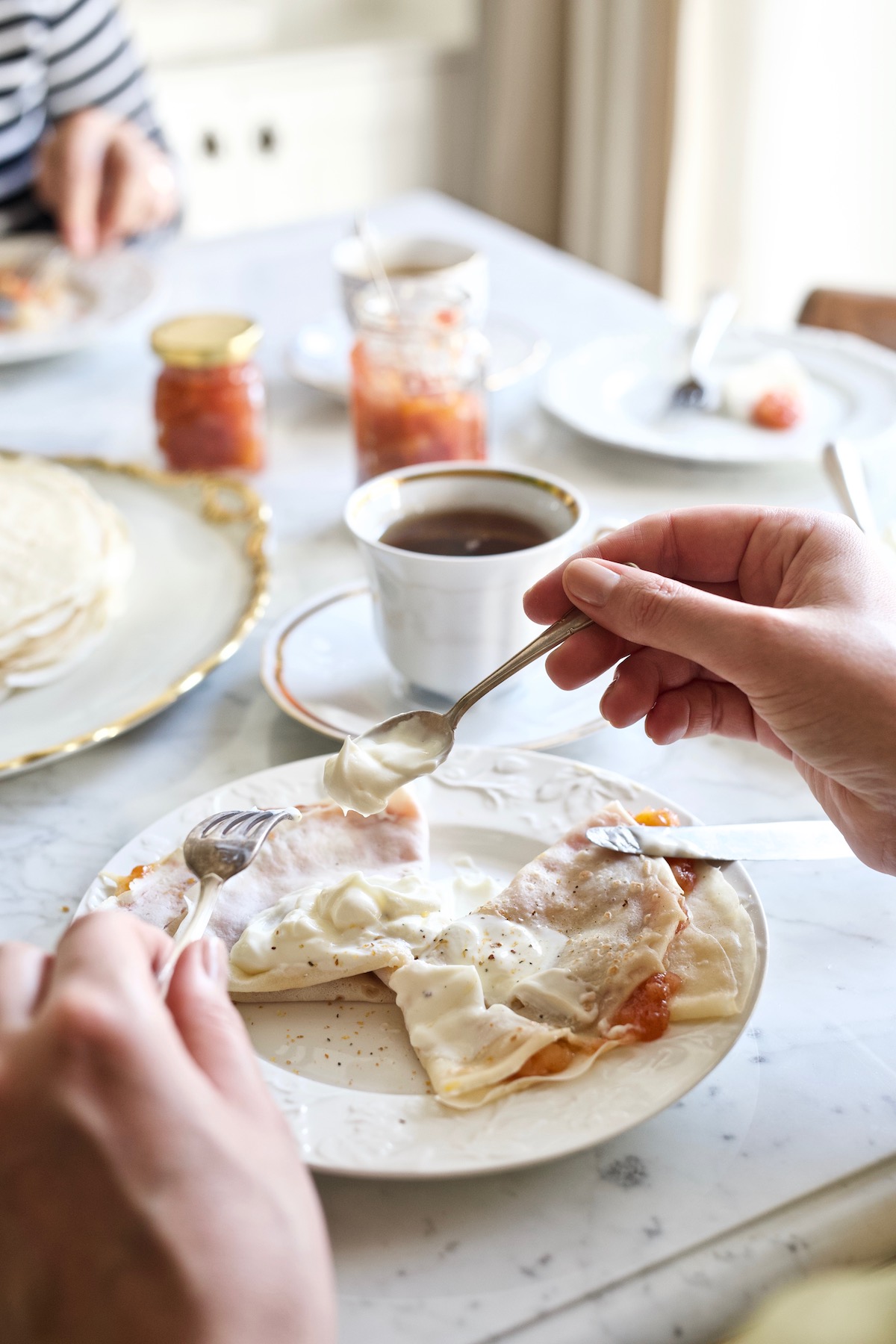 The ready preserve can be served with pancakes, ricotta, and thick Greek yoghurt.
The ready preserve can be served with pancakes, ricotta, and thick Greek yoghurt.
Tak powstałą konfiturę podaję z naleśnikami, ricottą i gęstym jogurtem greckim.









Komentarze